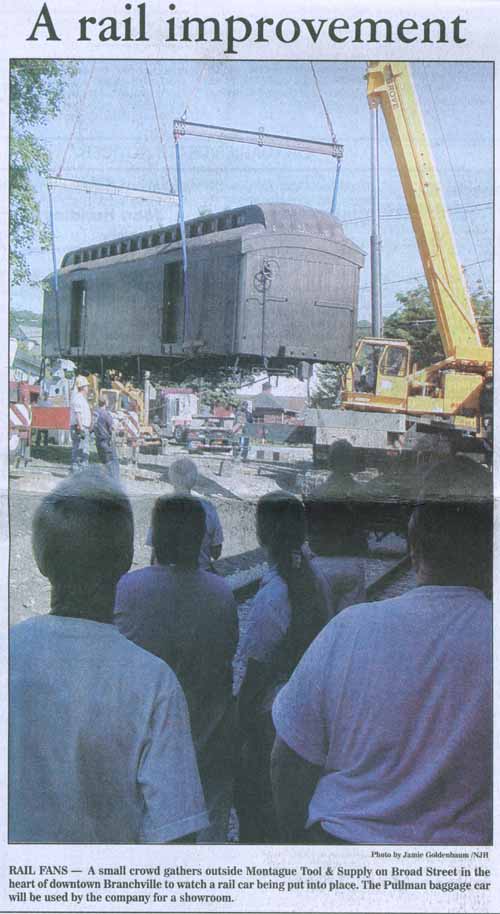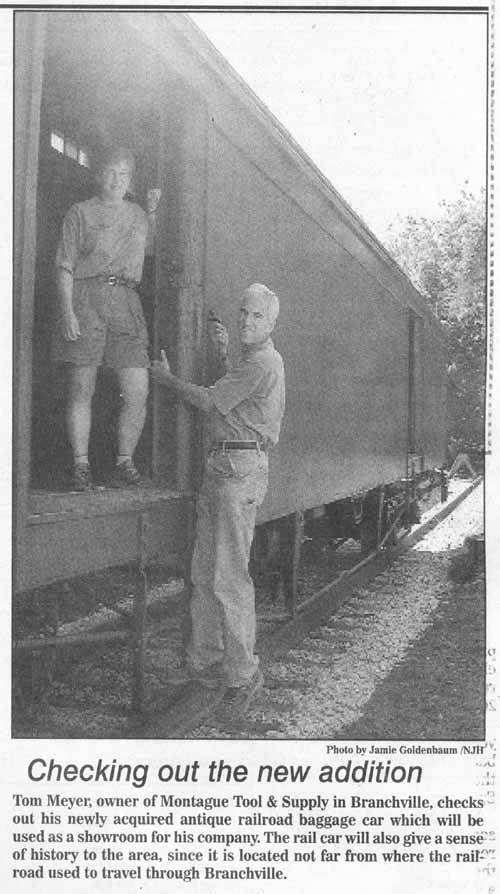| Main Index |
| History Index |
| Modeling Index |
| 1840's |
| 1850's |
| 1860's |
| 1870's |
| 1880's |
| 1890's |
| 1900's |
| 1910's |
| 1920's |
| 1930's |
| 1940's |
| 1950's |
| 1960's |
| 1970's |
| 1980's |
| 1990's |
| 2000's |
Archives>Article
New Jersey Herald - July 2, 2003 issue
A Rail Improvement
Montague Company Adds Space and a Touch of History
By Jamie Goldenbaum
Herald Staff Writer
BRANCHVILLE -- "I think Branchville is on its way to a renaissance," said Tom Meyer as he watched a crane lower his newly acquired 55-foot-long Pullman baggage car onto tracks behind his borough business.
An avid history buff, Meyer saw his antique train car as an example of strategic planning initiatives being developed throughout Sussex County to create more aesthetically pleasing development.
So, he decided to revamp the antiquated piece of machinery for a modern purpose.
Instead of of building an addition onto his business -- Montague tool & Supply Co., Inc. Meyer intends to have the Pullman baggage car serve as the new showroom for tools or construction equipment.
Meyer, who also chairs the county Shade Tree Commission, came across the antique, turn-of-the-century railroad car on the internet about six months ago when it went on the auction block.
But, the project has been on Meyer's mind for about three years, said wife, Sue Stark.
Meyer thought about bidding on the baggage car, but he was busy when bidding commenced. The car was purchased by another group.
When that project was scrapped, Stark said, the baggage car became available again. So, the couple bought the vehicle for $30,000.
It's not cheap, but it's less expensive than adding on to the building," Meyer said.
Two cranes, their operators and about a half-dozen men on the ground maneuvered Meyer's 1905 Pullman baggage car onto a 150-foot length of track specifically constructed to accommodate one or two railroad cars behind the business.
"If ever I need more office space, I'll just buy another railroad car," Meyer said.
The Henry Ford Museum in Greenfield Village, Mich., got rid of two antique railroad cars to make room for a new collection, said Meyer, who described the lush features and large windows of the observation railroad car that also went on the auction block.
Transporting the baggage car from Detroit to Branchville cost Meyer another $12,000, he said.
Last week, Vealey Excavating of Branchville laid down the 132 lb. railroad track behind Montague Tool & Supply in preparation for the baggage car's arrival, Stark said. Industrial Process & Equipment of Wantage organized crane operators and the ground crew to put the railroad car on the track.
Not much renovation to the car is needed--the inside wood paneling and yellow-stained glass windows are still intact -- but Meyer said the roof needs to be tarred black and one wooden panel inside needs to be fixed.
Having the railroad car behind the building could be considered a step back in time.
The Sussex Railroad, which passed through Branchville, became the Sussex Branch of the Delaware, Lackawanna & Western Railroad after the company purchased the line, said David E. Rutan, a historian of the DL&W Sussex Branch.
Stretching more than 21 miles through Sussex and Morris counties, the railroad line had stations in Mount Olive, Netcong, Andover Borough, Andover Twp., Byram, Newton, Lafayette, and Branchville. The tracks leading into the Branchville station passed behind the old Agway location, which is now the location of Montague Tool & Supply.
The rail car has been placed about 15 feet from the old railroad bed, which is to be developed as a rail trail for hikers. Meyer anticipates people on the trail will feel as if they have entered a time warp when passing by the antique rail car.
Pointing to a barn-type door on the back of his business, Meyer said the train would stop at the building and drop off feed at the rear of the structure before docking at the adjacent Branchville station.
Rutan said the borough railroad station played an intricate role in the borough a century ago for three reasons: Railroad was the primary mode of transportation for moving agriculture products out of the area; the train was widely used by city people, who vacationed on nearby Culver Lake, and businessmen made use of train travel to visit families and conduct business.
The last train pulled out of Branchville on July 10, 1966, according to Rutan. The Branchville station stood for 125 years and was used for 97 years.
[Notice that a lot of the information attributed to me is not in quotes. The reporter apparently visited my website and did not quite digest the information completely.--DR]

